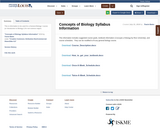
This is information to be used for a General Biology I course (or Introduction to Biology I) for non-science majors.
- Subject:
- Biology
- Natural Science
- Material Type:
- Syllabus
- Provider:
- LOUIS: The Louisiana Library Network
- Date Added:
- 07/31/2019

This is information to be used for a General Biology I course (or Introduction to Biology I) for non-science majors.
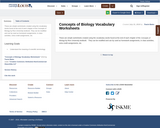
These are simple worksheets created using the vocabulary words found at the end of each chapter of the Concepts of Biology by Rice University textbook. They can be modified and can by used as homework assignments, in class activities, extra credit assignments, etc.
Terminology Matching Key is available upon request. Use the Help Center to open a new support ticket to request this.

This is information to be used for a General Biology I (or Introduction to Biology) course for non-science majors.
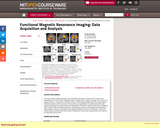
" This team-taught multidisciplinary course provides information relevant to the conduct and interpretation of human brain mapping studies. It begins with in-depth coverage of the physics of image formation, mechanisms of image contrast, and the physiological basis for image signals. Parenchymal and cerebrovascular neuroanatomy and application of sophisticated structural analysis algorithms for segmentation and registration of functional data are discussed. Additional topics include: fMRI experimental design including block design, event related and exploratory data analysis methods, and building and applying statistical models for fMRI data; and human subject issues including informed consent, institutional review board requirements and safety in the high field environment. Additional Faculty Div Bolar Dr. Bradford Dickerson Dr. John Gabrieli Dr. Doug Greve Dr. Karl Helmer Dr. Dara Manoach Dr. Jason Mitchell Dr. Christopher Moore Dr. Vitaly Napadow Dr. Jon Polimeni Dr. Sonia Pujol Dr. Bruce Rosen Dr. Mert Sabuncu Dr. David Salat Dr. Robert Savoy Dr. David Somers Dr. A. Gregory Sorensen Dr. Christina Triantafyllou Dr. Wim Vanduffel Dr. Mark Vangel Dr. Lawrence Wald Dr. Susan Whitfield-Gabrieli Dr. Anastasia Yendiki "

Survey of Cellular Biology is intended for one term of the introductory biology course for non-science majors taught at many two- and four-year colleges. The concepts of cellular biology, as they apply to the study of life, are introduced, including parts of a cell, metabolism, and homeostasis.

General Biology is intended to leave the student with an integrated view of the living world including the nature of sciences, evolution of biological organization, composition and organization of living substances, metabolism, control, reproduction, heredity and ecological relationships. This class meets the A.A. degree lab science requirement in the State of Washington.Login: guest_oclPassword: ocl

Based on over 20 years of teaching experience in animal nutrition, this study guide will enhance learning basic food animal nutritional principles.
In this introductory text, six fundamental nutrients, their structure, digestion, and metabolism are covered. A brief introduction to bioenergetics, feed additives, nutrient analysis, digestive organs and processes in monogastric and ruminant animals, and methods for assessing nutrient utilization are also included.
Each chapter is illustrated with a new terms box, key points, and review questions.
This study guide is an essential learning tool for undergraduate students majoring in animal sciences, veterinary medicine, or other related disciplines.
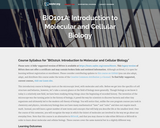
Though biology as we know it today is a relatively new field, we have been studying living things since the beginning of recorded history. This introductory course in biology starts at the microscopic level, with molecules and cells, then moves into the specifics of cell structure and behavior. Upon successful completion of this course, students will be able to: Describe in general terms how life began on Earth; Identify early scientists that played important roles in furthering our understanding of cellular life; Describe the characteristics that define life; List the inorganic and organic molecules that are necessary for life; List the structure and function of organelles in animal and plant cells; List the similarities and differences between animal and plant cells; Describe the reactions in photosynthesis; Explain how the different photosynthetic reactions are found in different parts of the chloroplast; Describe the sequence of photosynthetic reactions; Explain the use of products and the synthesis of reactants in photosynthesis; Explain how protein is synthesized in eukaryotic cells; Describe the similarities and differences between photosynthesis and aerobic respiration; List the reactions in aerobic respiration; Explain the use of products and the synthesis of reactants in aerobic respiration; Describe the similarities and differences between anaerobic and aerobic respiration. (Biology 101; See also: Psychology 203)
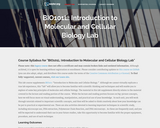
This lab course supplements Introduction to Molecular and Cellular Biology. Although it does not replicate a true lab experience, it does enable further exploration of some key principles of molecular and cellular biology. In each unit, the student will work through tutorials related to important scientific concepts, and then will be asked to think creatively about how those concepts can be put to practical or experimental use. This lab course also contains activities devoted to learning important techniques in scientific study such as microscope use, DNA extraction, Polymerase Chain Reaction, and examination of DNA microarrays. Upon successful completion of this lab supplement, students will be able to: Identify the important components of scientific experiments and create their own experiments; Identify the molecular differences between proteins, fats, and carbohydrates, and explain the molecular behavior of water; Describe the process of photosynthesis; Describe the process of cellular respiration; Identify the differences between DNA and RNA; Describe the entire transcription/translation process, from gene to protein; Explain how recombinant genomes are formed; Use critical thinking to find ways that any of the above natural processes might be altered or manipulated; Explain how to use a compound light microscope for data collection; Explain how to conduct and use various experimental techniques, including DNA extraction, PCR, and DNA microarrays. (Biology 101 Laboratory)
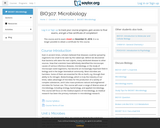
This course will cover a range of diverse areas of microbiology, including virology, bacteriology, and even applied microbiology. This course will focus on the medical aspects of microbiology, as medical research has been the primary motivator in microbiology research. Upon successful completion of this course, the student will be able to: explain how organisms are classified using taxonomy, focusing on the domains Archaea, Bacteria, and Eukarya; describe the chemical building blocks and metabolic processes important to sustain microbial life; identify the major principles of microbiology and describe the relationship between microbes and other living organisms; discuss pathogenic microbes and their epidemiology; differentiate between microorganisms based on their shape, size, arrangement, staining, and culture characteristics; outline antimicrobial methods including antibiotic use; explain how the human body protects itself; list uses for microbiology in food and beverage preparation and industry. (Biology 307)

This book is designed as an OER text and learning resource for undergraduate students enrolled in FN 225 Nutrition at Lane Community College in Eugene, Oregon. The book covers basic nutrition and metabolism, information literacy, energy balance, nutrition across life stages, dietary supplements, an in-depth look at each of the macronutrients, and major functions of vitamins and minerals.

Biology is designed for multi-semester biology courses for science majors. It is grounded on an evolutionary basis and includes exciting features that highlight careers in the biological sciences and everyday applications of the concepts at hand. To meet the needs of today’s instructors and students, some content has been strategically condensed while maintaining the overall scope and coverage of traditional texts for this course. Instructors can customize the book, adapting it to the approach that works best in their classroom. Biology also includes an innovative art program that incorporates critical thinking and clicker questions to help students understand—and apply—key concepts.
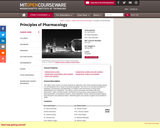
An introduction to pharmacology. Topics include mechanisms of drug action, dose-response relations, pharmacokinetics, drug delivery systems, drug metabolism, toxicity of pharmacological agents, drug interactions, and substance abuse. Selected agents and classes of agents examined in detail.